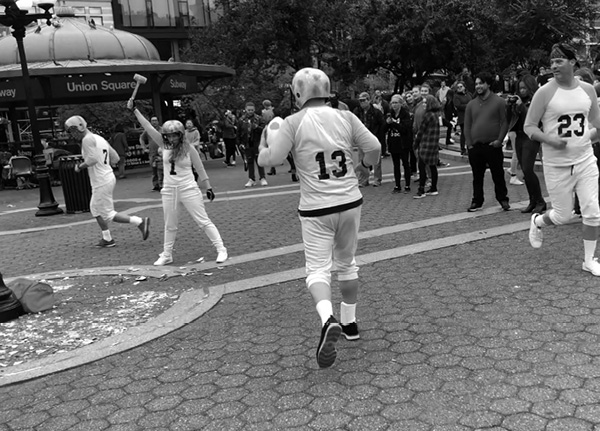
OFF THE GRID-IRON
first performed on October 14, 2018
Union Square, New York, NY
performed once in 2018
TREIZMAN / BRAZIL
Wilson Parry, Yasha Feferholtz
New York, NY / Los Angeles, CA
988941590a988941590d988941590a988941590m988941590@988941590a988941590d988941590a988941590m988941590b988941590r988941590a988941590z988941590i988941590l988941590.988941590c988941590o988941590m
OFF THE GRID-IRON
TREIZMAN / BRAZIL
“Off the Grid-iron” challenged definitions of masculinity and the segregated practice of sport in American culture through a material object (glazed ceramic footballs), ritual, and playful engagement with the public. Thirty vibrantly glazed footballs were produced over a three-month period to be utilized throughout the performance. In order to engage the public, three male performers adorned in pink and white football uniforms executed a ritual running and passing of the balls up 14th street. Passersby partook in the playful tossing of the cast ceramic objects as our male performers dodged and weaved through the public on a bright sunny Sunday, a day typically associated with the game. Once the runner reached the “end-zone” in Union Square, Denise Treizman smashed each ball with a dead-blow hammer. After the smashings, she spread the shards out over the plaza, forming a colorful improvised mosaic. As a final ritual act, we all united after the last football was smashed in order to sweep the large array of ceramic shards into a pink duffle bag, and then deposited them in the gallery.
“Off the Grid-iron” mobilized sport to comment on notions of health, gender, and body image. The vibrantly colored footballs satirized the overly serious and conservative culture of American football, and functioned as vessels of energy to be passed from passerby to passerby, until they reached their end zone, where the female performer smashed them, shattering the exclusionary practice of American football. During the performance, an observer was heard sternly shouting “football players don’t wear pink!” The performance commented on the nature of spectacle in the capitalistic paradigm where athletic competitions are produced and consumed, and the athlete’s body becomes a commodity object.